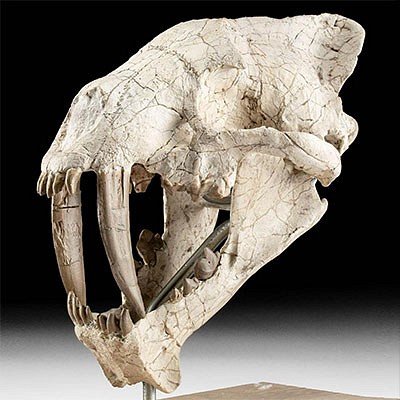2 Fossilized Ammonite Matrices w/ Orthoceras & Baculite
Lot 24
About Seller
Artemis Fine Arts
686 S Taylor Ave, Ste 106
Louisville, CO 80027
United States
Selling antiquities, ancient and ethnographic art online since 1993, Artemis Gallery specializes in Classical Antiquities (Egyptian, Greek, Roman, Near Eastern), Asian, Pre-Columbian, African / Tribal / Oceanographic art. Our extensive inventory includes pottery, stone, metal, wood, glass and textil...Read more
Estimate:
$400 - $600
Absentee vs Live bid
Two ways to bid:
- Leave a max absentee bid and the platform will bid on your behalf up to your maximum bid during the live auction.
- Bid live during the auction and your bids will be submitted real-time to the auctioneer.
Bid Increments
| Price | Bid Increment |
|---|---|
| $0 | $25 |
| $300 | $50 |
| $1,000 | $100 |
| $2,000 | $250 |
| $5,000 | $500 |
| $10,000 | $1,000 |
| $20,000 | $2,500 |
| $50,000 | $5,000 |
| $100,000 | $10,000 |
| $200,000 | $20,000 |
About Auction
By Artemis Fine Arts
Jul 13, 2021
Set Reminder
2021-07-13 12:00:00
2021-07-13 12:00:00
America/New_York
Bidsquare
Bidsquare : Fauna, Flora, Stones & Bones
https://www.bidsquare.com/auctions/artemis-gallery/fauna-flora-stones-bones-7214
Join us for a very special summer auction featuring fabulous fossils, rocks, and minerals, plus art depicting flora and fauna from antiquity to present day. This is one you won't want to miss! Artemis Fine Arts info@artemisgallery.com
Join us for a very special summer auction featuring fabulous fossils, rocks, and minerals, plus art depicting flora and fauna from antiquity to present day. This is one you won't want to miss! Artemis Fine Arts info@artemisgallery.com
- Lot Description
Ancient Seas, Russia, Saratov, Jurassic period, 201.3 to 145 million years ago; North America, Late Cretaceous period, 100.5 to 66 million years ago. A lovely pair of stone matrixes containing fossilized shells of ammonites and other sea creatures. The first display contains 3 quenstedtoceras ammonites, known for their tightly closed spirals and ribbed shells, which are wonderfully exemplified here! The shells have also opalized to a red and pink iridescent glimmer. Their shell openings have been coated with flecks of pyrite to enhance these radiant fossils. The larger display features 4 ammonites and fragments of orthoceras shells in a matrix. Projecting from the side is a large column from a baculite, a heteromorph ammonite with a straight rather than spiraling shell. The baculite retains much of the nacre (mother of pearl) outer layers and has interesting fern like suture patterns near the base. Size of smaller display: 2.5" L x 2.3" W x 2.675" H (6.4 cm x 5.8 cm x 6.8 cm); larger: 4.6" L x 3" W x 7.75" H (11.7 cm x 7.6 cm x 19.7 cm)
Provenance: ex-Stein collection, Bloomfield Hills, Michigan, USA, acquired prior to 2010
All items legal to buy/sell under U.S. Statute covering cultural patrimony Code 2600, CHAPTER 14, and are guaranteed to be as described or your money back.
A Certificate of Authenticity will accompany all winning bids.
PLEASE NOTE: Due to recent increases of shipments being seized by Australian & German customs (even for items with pre-UNESCO provenance), we will no longer ship most antiquities and ancient Chinese art to Australia & Germany. For categories of items that are acceptable to ship to Australia, please contact us directly or work with your local customs brokerage firm.
#165938Both are professionally prepared. Smaller display has some chips and nicks to high pointed areas. All three ammonites have been posed and stabilized on a matrix. Pyrite is added with adhesive to cover shell openings and areas of adhesive where shells attach to matrix. Small area of modern material infill on verso of largest ammonite. The larger display is repaired with break lines encircling baculite shell in three places and loss along the lines. Baculite has been attached with adhesive to stone matrix. Chips to nacre layers. Stable fissures from fossilization. Ammonite shells are well preserved on both displays.Condition
- Shipping Info
-
All shipping is handled in-house for your convenience. Your invoice from Artemis Gallery will include shipping calculation instructions. If in doubt, please inquire BEFORE bidding for estimated shipping costs for individual items.
-
- Buyer's Premium



 EUR
EUR CAD
CAD AUD
AUD GBP
GBP MXN
MXN HKD
HKD CNY
CNY MYR
MYR SEK
SEK SGD
SGD CHF
CHF THB
THB













